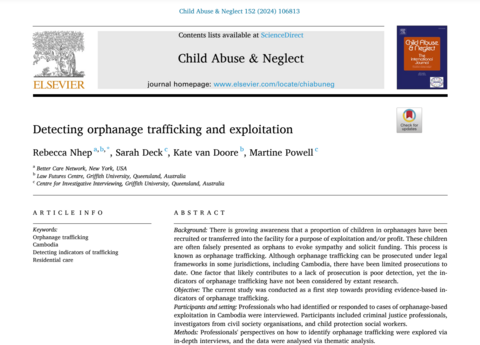Abstract:
Background:
There is growing awareness that a proportion of children in orphanages have been recruited or transferred into the facility for a purpose of exploitation and/or profit. These children are often falsely presented as orphans to evoke sympathy and solicit funding. This process is known as orphanage trafficking. Although orphanage trafficking can be prosecuted under legal frameworks in some jurisdictions, including Cambodia, there have been limited prosecutions to date. One factor that likely contributes to a lack of prosecution is poor detection, yet the indicators of orphanage trafficking have not been considered by extant research.
Objective:
The current study was conducted as a first step towards providing evidence-based indicators of orphanage trafficking.
Participants and setting:
Professionals who had identified or responded to cases of orphanage-based exploitation in Cambodia were interviewed. Participants included criminal justice professionals, investigators from civil society organisations, and child protection social workers.
Methods:
Professionals' perspectives on how to identify orphanage trafficking were explored via in-depth interviews, and the data were analysed via thematic analysis.
Results:
The analysis revealed a distinct set of indicators that may be used to detect orphanage trafficking, including the operation of an unauthorised facility, orphanage tourism and volunteering, and an overt focus on fundraising.
Conclusion:
The indicators revealed in this study point to the need for an effective and thorough monitoring system for orphanages, as well as adequate education and training of relevant personnel to aid in the detection of orphanage trafficking.

